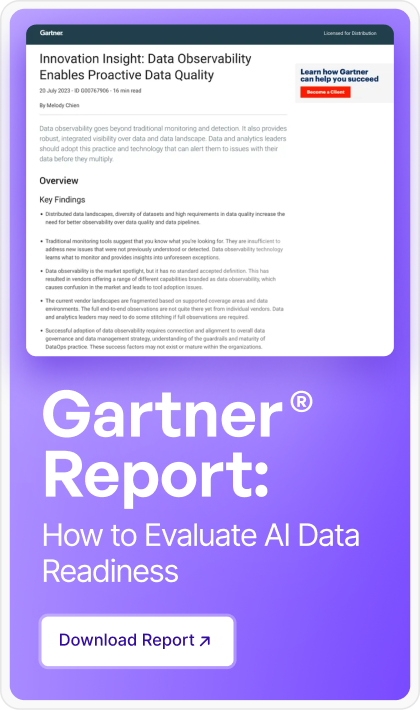Enterprises are collecting, producing, and processing more data than ever before, but IT teams quickly learn that having reams of data doesn’t do much good if it’s incomplete, inconsistent, or out-of-date. Data is measured by its accuracy and usability, but it must also be relevant to the context of specific business issues to be valuable.
Since data provides the foundation for all manners of analysis and business decisions, organizations must ensure that the data on which they rely is always high quality and consistently accessible. Bad, or low-quality, data, in contrast, leads to issues, which can derail businesses and have serious negative impacts on growth and profitability. Examples of issues with poor data qualityinclude:
- Increased operational costs: Flawed data lead to costly decisions that can create organizational inefficiencies. Usually, the discovery of poor data isn’t recognized until after considerable time and money have been misallocated towards misguided goals.
- Security and compliance risk: Bad data can lead to false positives, which in turn can carry security and compliance risk. This creates vulnerabilities within the environment that even security teams might not recognize until after a breach has occurred..
- Growth limitations: When an organization uses bad data - even if done inadvertently - every touch point of the business is impacted. Companies cannot build the right products, service their customers effectively, or optimize resource allocation if they are operating off the wrong targets. Decisions that result from bad data are costly. According to Gartner, organizations estimate the average cost of poor data quality at nearly $13 million per year. In 2016, IBM estimated that poor data quality cost enterprises in the United States $3.1 trillion annually.
In this blog, we’ll cover the multiple dimensions of data quality and what enterprises can do to ensure they are relying on high-quality data to support their business operations and objectives.
Defining data quality
In its simplest form, data is high quality if it accurately describes the real-world. And to accurately describe the real world, data must exhibit six necessary characteristics. High-quality data must be:
- Accurate - Is the correct account balance a dollar, or is it a million dollars? Inaccurate data is meaningless, and even worse, can lead to costly, time-consuming errors.
- Complete - Does the data in question describe a fact completely, or is it missing key elements? Without complete data, an organization is unable to see all facets of the issues they encounter.
- Consistent - Is the data being used for a given purpose consistent with the related data points stored elsewhere in the system? There has to be some relationship between and among data elements, and these must be identified and used appropriately.
- Fresh - How old is the data element? Does it still reflect current business realities, or is it stale and no longer representative of the current status? Stale data can lead to bad, erroneous decisions.
- Valid - Does data conform to schema definitions and follow business rules? If data sets cannot communicate because they are invalid, you will only see partial information.
- Unique - Is there a single instance in which this information appears in the database? Multiple instances can lead to version control issues and gaps in data.
In order to ensure these six data quality requirements, organizations need to establish checkpoints across the entire data pipeline. This helps prevent data downtime, eliminate data reliability challenges, and provide early warnings if there are data quality issues.
Establishing effective data quality programs
Whether you’re working with structured data tables or unstructured data in a hybrid data warehouse managed by a metastore, it’s important to create data quality programs that ensure all data users have access to high-quality assets.
Establishing effective data quality programs help ensure that data is accurate, complete, and timely throughout the entire data pipeline, from ingestion to consumption. To create effective data quality programs, businesses should be able to provide:
- Continuous data validation: Continuously validating data prevents schema non-conformance or structural issues. Automation can help reduce the workload.
- Accurate reporting: When data errors occur, report on both the error and cause of failure. Include ways to remediate the problem if possible.
- Real-time alerting: Failure notification should be prompt and provide enough contextual information to fix problems and prevent repeat occurrences.
With these six dimensions of data quality embedded into technology and business operations, enterprises can trust their data and be confident that it will lead to better decisions, effective decision-making processes, and ultimately, improved financial results.
Make poor data quality a thing of the past
Data is becoming the lifeblood of enterprises. In this context, data quality is only going to become more important. “As organizations accelerate their digital [transformation] efforts, poor data quality is a major contributor to a crisis in information trust and business value, negatively impacting financial performance,” says Ted Friedman, VP analyst at Gartner.
Organizations must improve data quality if they want to make effective data-driven decisions. But as data teams collect more data than ever before, manual interventions alone aren’t enough. They also need a data observability solution like Acceldata Torch, with advanced AI and ML capabilities, to augment the manual interventions and improve data quality at scale.
Book a free demo to learn how Acceldata can help your enterprise overcome poor data quality at scale.
Photo by Max van den Oetelaar on Unsplash






.png)







.webp)
.webp)


